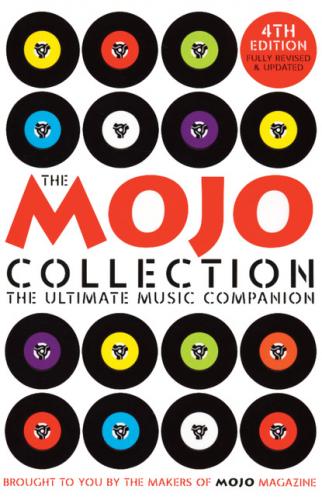Contents
The Album Is Dead!? Long Live The Album!
An introduction to The MOJO Collection
What Have We Here?
Making the best of The MOJO Collection
The Beginning
The first vinyl pop album
The 1950s
The Cold War breaks out. Hollywood stumbles, TV triumphs. The teenager is created. Jive turns to rock. The King arrives from the Sun. The US and USSR race to the moon. Kids race to the top of the British charts on washboards
The 1960s
You never had it so good. A US president assassinated, a British Cabinet disgraced. From Love Me Do to Let It Be. From I Saw Her Standing There to Visions Of Johanna. Psychedelics, pot, the pill. Colour TV, black power. The sex war breaks out. A call to women’s liberation. A giant leap for mankind
The 1970s
The dream is over. A Stairway To Heaven. LSD decimalised. The first clang of metal, the last days of peace and love. The singer-songwriter prospers. From high street hi-fi to Quadrophenia. Strikes, slumps, glitter, disco, punk, P-funk. “I will survive”/“No future.” The King is dead. God save the Dancing Queen
The 1980s
A new romance. Maggie, Ronnie and their pet yuppies. From Prince Charming to Terminator X. Video helps the radio star. The Me Generation speaks: “I want my MTV.” Frankie Says Relax. HIV. Live Aid. The silver disc for all; perfect sound forever. The PC arrives. Wall Street thrives, the Berlin Wall crumbles
The 1990s
Here we are now, entertain us. Take That and party. E’s are good. Hip hop don’t stop. Britpop gets hot. DCC flops. Corporate rock booms. DVD looms. Supa Dupa Fly and the World Wide Web
The 2000s
The new millennium, reality TV and the question Is This It? When it’s all Back to Black at a Funeral, and the angry young men are insisting that ‘Whatever People Say I Am, That’s What I’m Not’ whilst the older generation just keep grinding on …
MOJO Miscellaneous
The Easy Life
Lounging, and collecting the music it spawned
The Single Life
Reggae, the music that didn’t believe in the album
100 Great Soundtracks
Music to watch films by
The Best Of The Best Ofs
100 Great Compilations
Index
Find your favourite in an instant
The Album Is Dead!? Long Live The Album!
Welcome to an ever-changing world of sound and music …
Never in the history of the music industry have we enjoyed such a state of flux. The digital download revolution has created a sense of adventure and uncertainty in equal measure. More significant than that is the fact that it has actually opened up further avenues that allow for the greater discovery of music. The recent polemic among artists and the industry, however, has led to a debate as to whether the art form of the album is dead. Within that there are those who believe that it is and that tracks have superseded collected bodies of work, and then there are the zealots who maintain that no meaningful musical statement can be made without a full exposition of an artist’s talent. In truth, both parties are right and have precedents to prove it.
In the case of the Track-ites (as we shall call them), they need but point to the fecund world of early blues and R&B to showcase the fact that short, sharp commercial statements have also been hugely important in the development of popular music. The Album-ites however can point to music’s most fertile period of 1965 to 1985, during which the long-player held sway and produced some of the defining statements in popular culture. Either way, the key within all of this is the quality of the music, and that’s where The MOJO Collection comes in.
Essentially the weighty tome you hold in your hand was conceived over a long period of time, the initial conversations dating back to 2000. The first volume of the book was commissioned and edited by MOJO’s very own Jim Irvin, who meticulously and expertly created a basis of this encyclopaedia. Since then music has of course refused to sit still, hence the revisions and additions that have been made throughout the various editions and which brings us to this very latest volume.
Of course, even as I write there are a number of albums that spring to mind as worthy inclusions (I could list them, but the list would be too long). Then there’s the manner in which we should probably incorporate tracks and singles. These, however, are philosophical debates that are bound to run and run and revisions that we will continue to make as the book continues to grow and evolve.
Despite all this and regardless of any sea changes that may occur in the manner in which music is consumed, The MOJO Collection should provide you with a sound basis on which to build the best music collection in the world. And should you need more recommendations, then do join us in our monthly celebration of music that is MOJO magazine, or via the message-boards of www.mojo4music.com, where boasting about music is actively encouraged.
Until the fifth edition, then, friends …
PHIL ALEXANDER
Editor-In-Chief MOJO
London, England
September, 2007
Making the best of The MOJO Collection
The albums are arranged chronologically by release date. At the rear of the book are indexes by artist and album title. This is a celebration of an art form – the pop album. We’ve selected hundreds of them from the very first vinyl pop album in 1946 to important releases from the first half of 2007 – and found out how they happened.
As well as the main text for each album, every entry of The MOJO Collection comprises the following information where available:
Artist
Album Title
If an album is known by more than one name we’ve used that of the original issue
Label
The label the album originally appeared on in the UK
Producer
